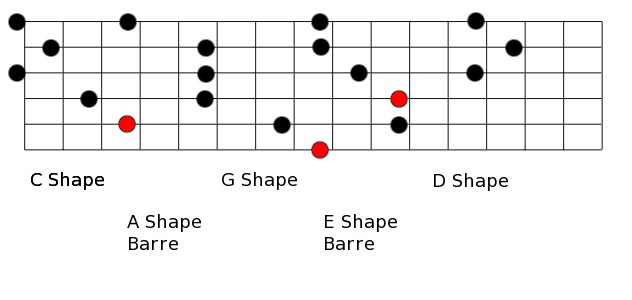The Major Chord Shapes
One time a guy came up to me after hearing me play. "You're a really good guitarist," he said, "Do you know how I know?" "No," I answered, somewhat shocked. In response he said, "Because you play chords high up on the neck!"
When we solo, we're usually playing over some kind of chord progression, usually a bunch of major and minor chords. There's usually a bunch of scales that go with the progression (which is great), but it's also helpful to think of soloing as playing notes in the chords. This leads to arpeggios and sweeps as part of soloing. It's also helpful when someone throws a weird chord outside the key in their progression and you still want to solo and sound good.
CAGED
The CAGED system is a great way to visualize major chords all over the fretboard. Hopefully you learned the "basic" chords when you picked up the guitar - the C, A, G, E, and D major chords. Those are the shapes we're using, but moved up the fretboard. Those shapes are all movable! Guitar is great! Remember that *all* of the chords below are C major:

Practice playing through these shapes to get familiar with playing a C major all over the neck. Note that you can pick and choose which notes in a shape to play. For instance, I never play that entire G shape - it's just too huge and I can't get there fast enough. When I'm playing the G shape, I would play something like:
-5--------------------------5-------------------
-5-----OR-----5-----OR------5-------------------
-5------------5---------------------------------
--------------7---------------------------------
------------------------------------------------
Those all come from the G shape, but are shortened versions. But when I'm playing those, my brain is thinking "G shape". See what other "shortened" versions you can come up with. Start with that C shape, it's annoying too.
You can also shorten big barre chord shapes too. These small shapes are very common but come from the "big" shapes:
-8--5--13---------------------------------------
-9--5--12---------------------------------------
------------------------------------------------
------------------------------------------------
------------------------------------------------
Oh right, the red notes. Those are the notes I mentally use to connect the chord shapes. So when I'm playing the G shape and want to move up to the E shape, I use that note on the 8th fret to "pivot" shapes in my head. You can use them or ignore them.
Got That? Then Practice THIS
Once you've mastered playing a whole bunch of C major all over the guitar neck, pick another major chord and use the SAME pattern, pivoting to the next shape in the same way.
And once you spend some time on that, you may reach the level of "awesome". The final pinnacle of perfection with the CAGED system is to be able to play any major chord *anywhere* just by using the appropriate shape (at lightning speed, of course). This let's you play chord progressions in multiple places on the neck without moving all over - think quick, minimal changes. Here's an example:
-5--6--8----------------------------------------
-5--5--7----------------------------------------
-5--7--5----------------------------------------
------------------------------------------------
------------------------------------------------
C F G
I'm using part of the G, C, and D shapes there. Nothing moves more than two frets, and it's really easy to switch from one chord to another. How many other ways can you come up with to play something like C F G?